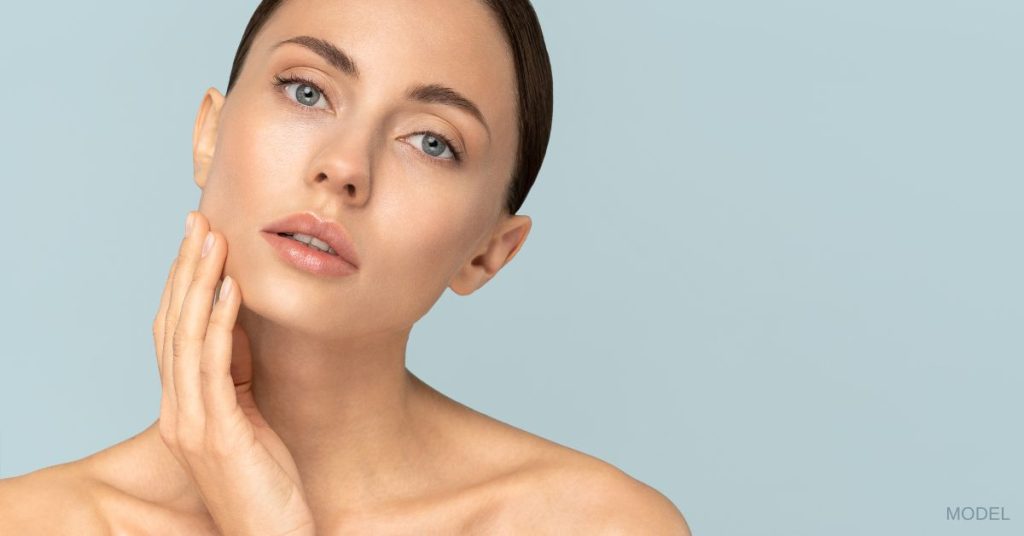The versatility of BOTOX® seems limitless. Initially approved by the FDA in 1989 to treat crossed eyes and eye twitching, it received its first cosmetic approval in 2002 to reduce vertical “worry lines” between the eyes. Since then, the number of cosmetic and medical conditions BOTOX can treat has significantly multiplied.
Each of these uses requires various amounts of BOTOX to get effective results. That’s why there’s no easy answer to the question, “How many units of BOTOX do I need?” In this blog post, we’ll provide an estimated number of units to treat a list of concerns.
How Many Units of BOTOX Is Normal?
The number of BOTOX units used for treatments varies depending on several factors. These include the following:
- Specific treatment area
- Patient’s aesthetic goals
- Gender (men generally need more BOTOX than women)
- Muscle strength
- Metabolism
The most popular areas for BOTOX facial treatments are the glabella (frown lines), forehead, crow’s feet (around the eyes), and neck.
BOTOX Units, Area-by-Area
Below we list the typical amount of BOTOX needed to treat specific concerns, but keep in mind that the amount you need will vary by some of the factors discussed earlier in this post. With long-term use, some people can achieve their desired results with less BOTOX.
1. How many units of BOTOX for 11 lines?
The pair of vertical lines between the eyebrows (hence, the “11s”) create a persistent frowning expression. BOTOX injections relax the 3 strong muscles that cause glabellar lines.
Units needed: 10-25
2. How many units of BOTOX for crow’s feet?
Often among the first signs of aging, these fine lines caused by squinting and smiling appear at the corners of the eyes. Some patients start getting BOTOX injections in their late 20s to smooth these wrinkles.
Units needed: 5-15
3. How many units of BOTOX for forehead wrinkles?
These horizontal lines develop when you elevate your brows. Women and men believe these wrinkles make them appear older. We use BOTOX conservatively to guard against the “frozen” appearance that results from using too many units of BOTOX.
Units needed: 10-30
4. How many units of BOTOX for brow lift?
BOTOX injections relax the underlying muscle between the brows to smooth the skin. This allows forehead muscles to pull up the now-relaxed muscles between the brows, elevating the brows and opening the eyes.
Units needed: 2-5 (outer brow only)
5. How many units of BOTOX for masseter muscle?
People with overdeveloped masseter muscles—the muscles in the upper jaw used when chewing food—get BOTOX injections to create a more V-shaped appearance. Sometimes called jawline slimming, the technique is becoming increasingly popular.
Units needed: 40-60
6. How many units of BOTOX for smile lines?
When you’re young, these folds that run from each side of the nose to the corners of the mouth appear when you smile or laugh and then disappear when your face relaxes. Over time, however, the lines become deep, permanent wrinkles and are present whether smiling or not.
Units needed: 4-10
7. How many units of BOTOX for bunny lines?
Smiling and laughing are also responsible for these tiny creases that develop just below the bridge of the nose. As with smile lines, they gradually deepen as we age.
Units needed: 5-10
8. How many units of BOTOX for a dimpled chin?
Injecting BOTOX into the muscle covering the chin, called the mentalis muscle, reduces the “orange peel” appearance that can develop with age.
Units needed: 2-6
9. How many units of BOTOX for a gummy smile?
If you’re self-conscious about how much of your upper gums are exposed when you smile, BOTOX offers a nonsurgical solution. BOTOX injections relax the muscle that pulls up on your lip when you smile, minimizing how much of the gum gets exposed.
Units needed: 3-6
We often combine BOTOX with JUVÉDERM® dermal filler injections because fillers treat different types of wrinkles caused by the loss of facial volume. If you’re interested in nonsurgical facial rejuvenation at our Anchorage, Alaska, practice, you can request a consultation using the online form or by calling us at (907) 563-2002.


Leave a Reply